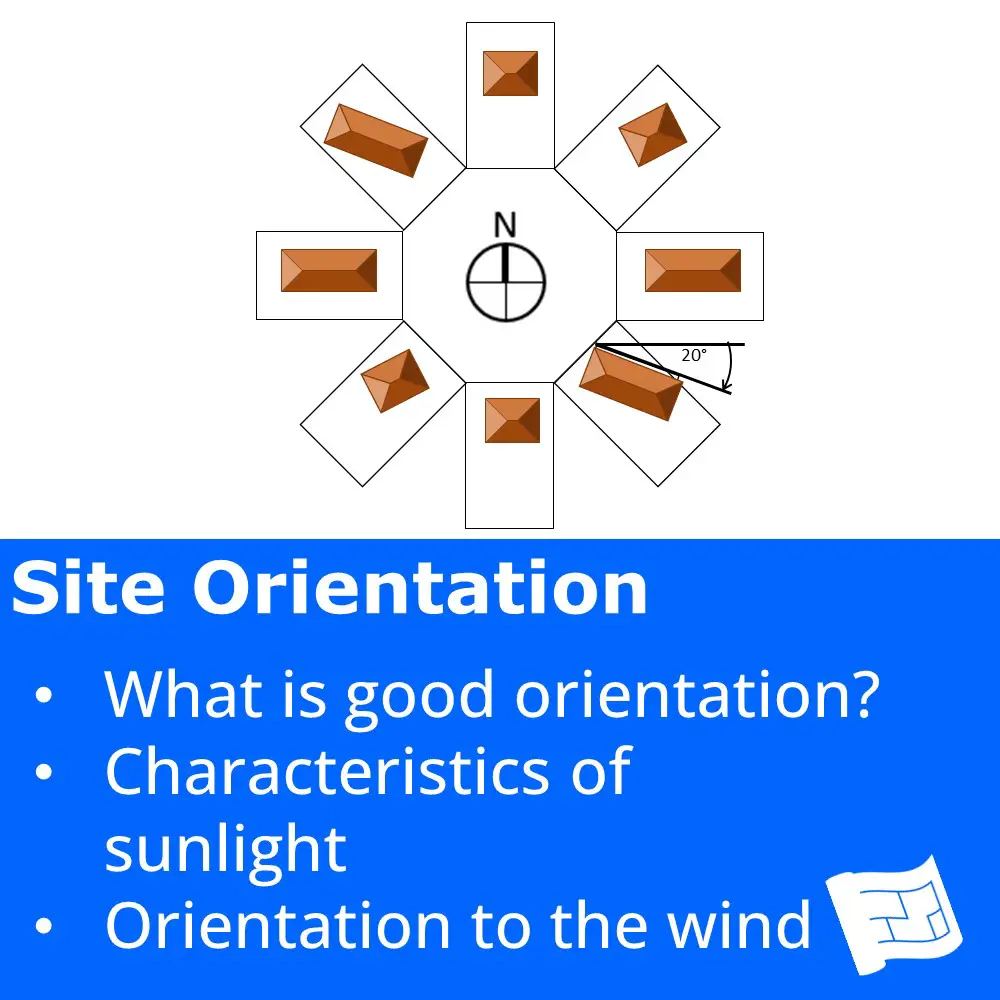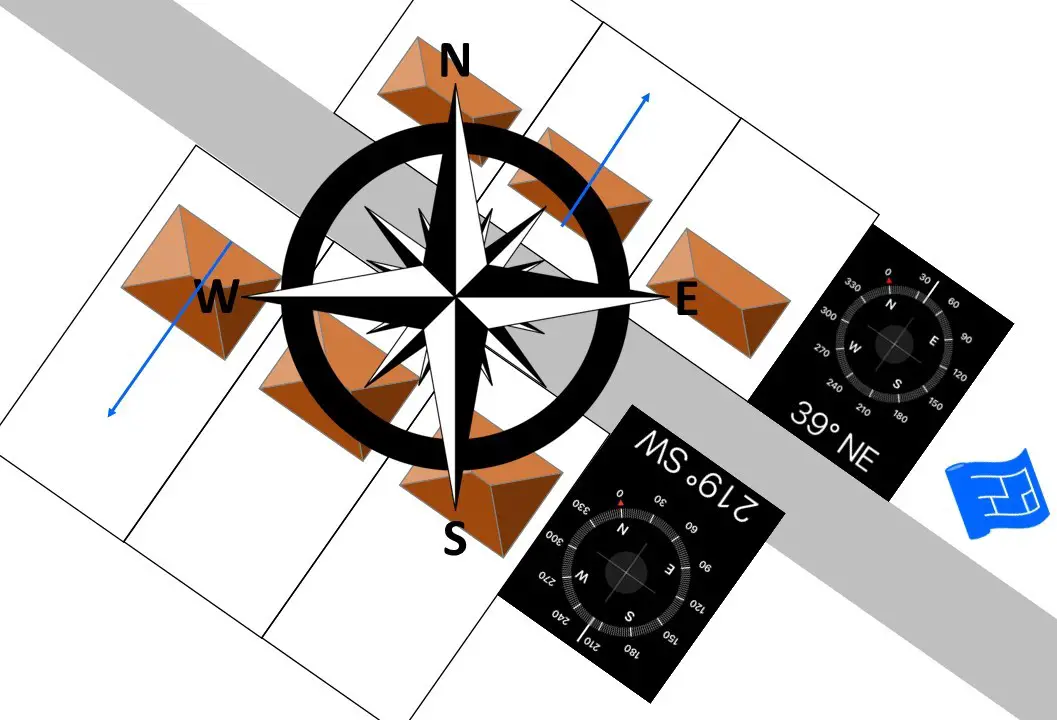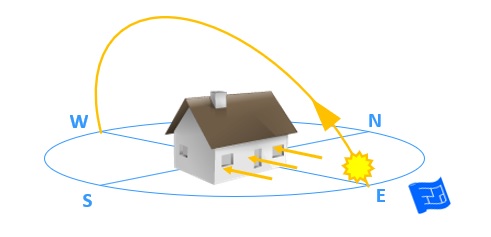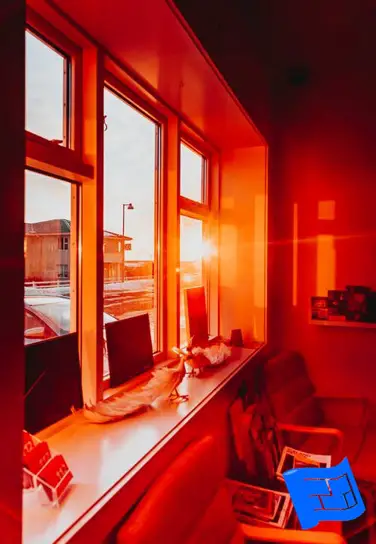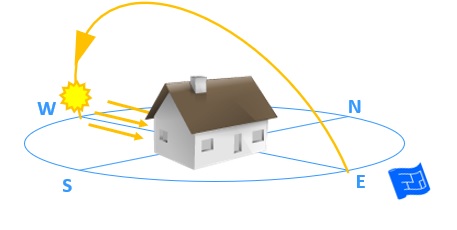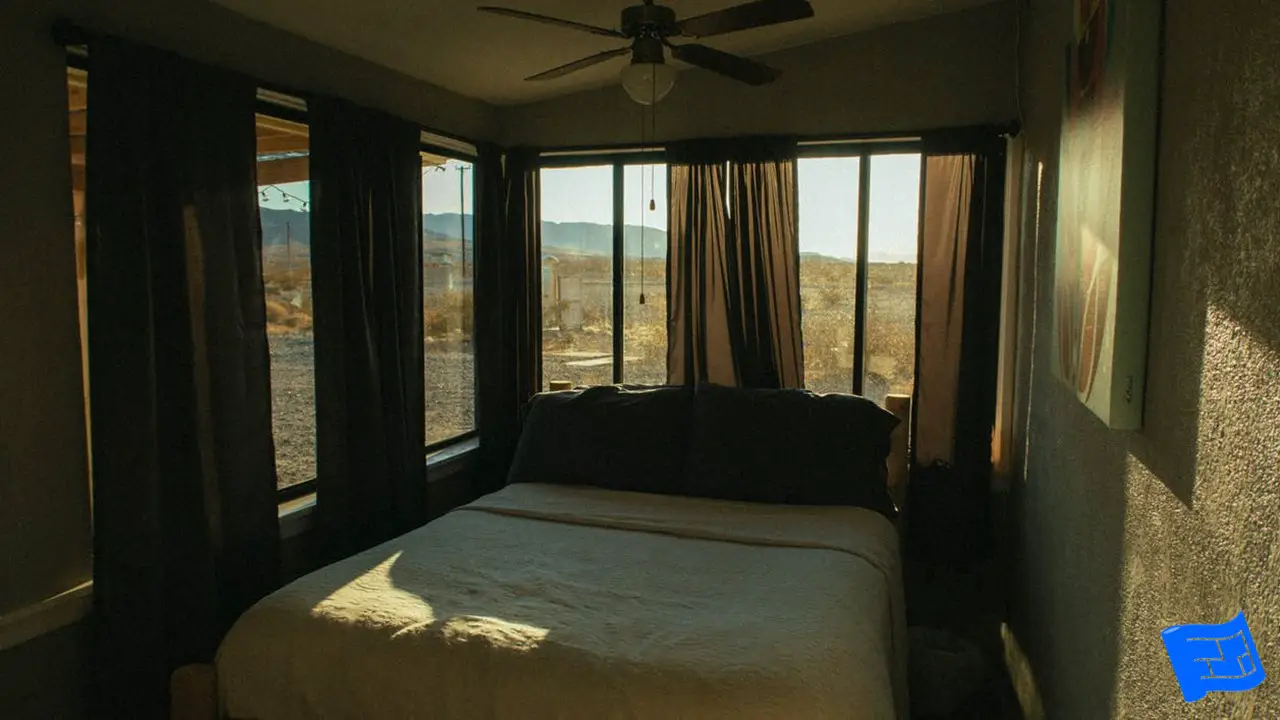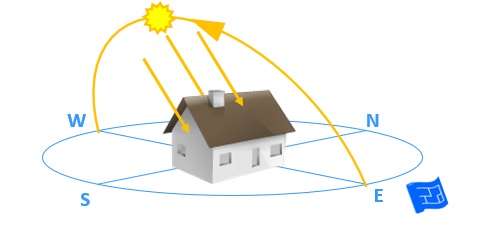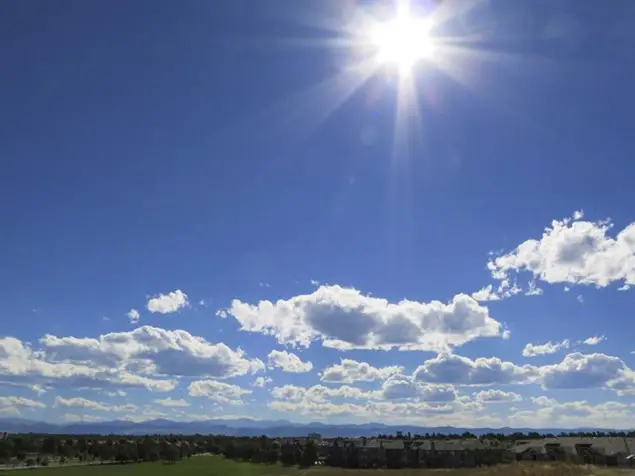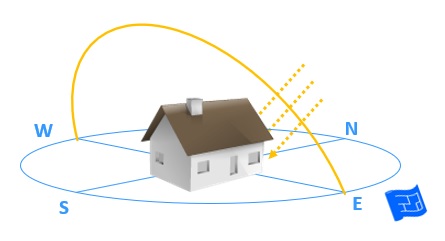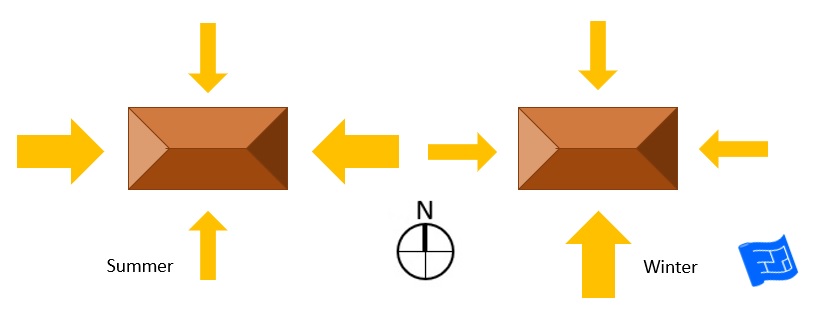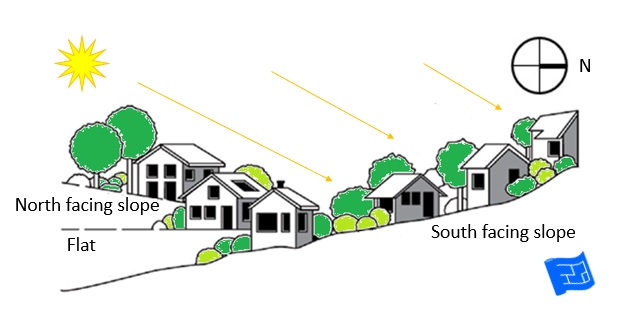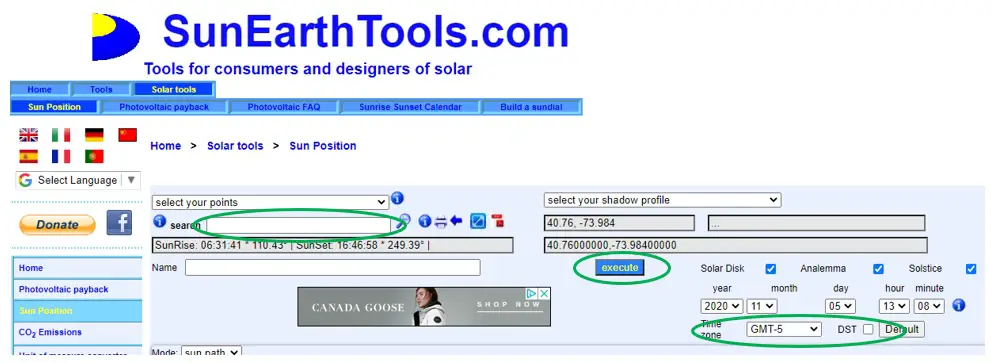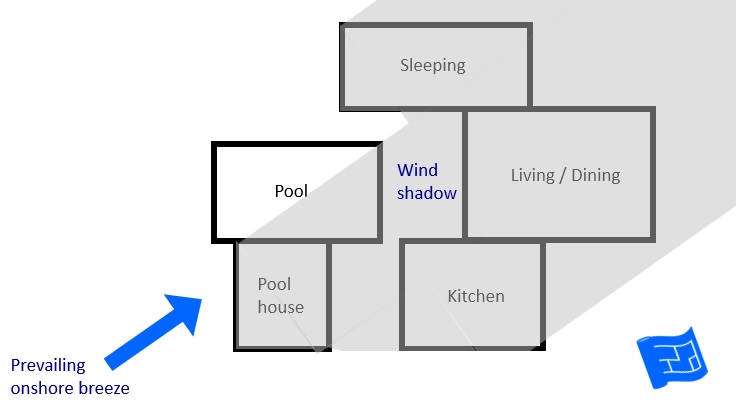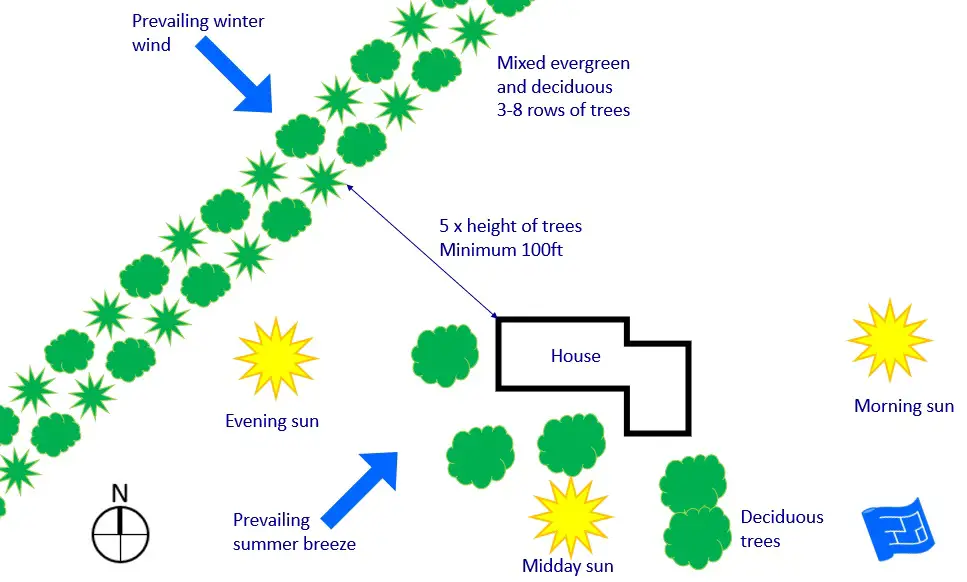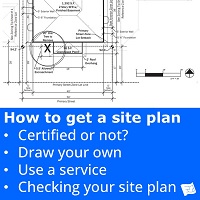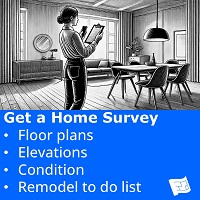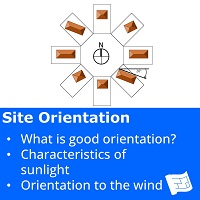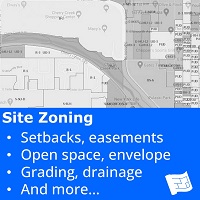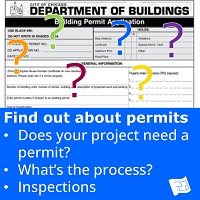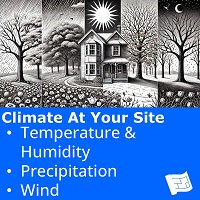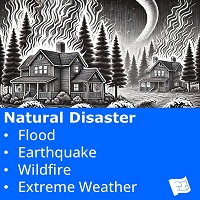- Home
- Your Lot ¦ Plot ¦ Site
- Site Orientation
Site Orientation
Understanding your site orientation and taking it into account when making design decisions is vital for a successful home design. It's a really important part of site analysis.
Understanding how the sun moves round your home and the prevailing wind direction allows you to design a home full of light and that doesn't get overheated if you live in a hot climate, and that takes advantage of the heat from the sun if you live in a cold climate.
Getting your design right with respect to your site orientation will mean that you take full advantage of the sun exposure for light, passive heating, and to generate electricity if you're contemplating solar panels. You'll also make sure the areas of your home that need protection from the sun are adequately protected.
You can also make design decisions to harness cooling breezes or protect your home from cold winds.
Definition of Site Orientation
Site orientation is about the direction your home faces in relation to the points of the compass.
You may well have heard talk about which way a home faces. Usually this is referring to the way where the main outdoor area (usually the back yard) lies in relation to the rest of the home. To find out the orientation of a home, draw a line from the home through the back yard and see what direction that is on the compass.
Characteristics of Sunlight
Our need for daylight and sunlight is instinctive and scientifically proven – we need daylight to keep our body clocks in tune and we need sunlight to make vitamin D. Not to mention sunshine is a great mood lifter.
We all know that the sun moves around in the sky and around our homes. The nature of the light from sunrise to sunset varies enormously and it's essential to understand the nature and quality of light from each of the compass directions to make good design decisions relating to your solar site orientation.

Which hemisphere?
The information on light from different directions is from the perspective of homes in the northern hemisphere where the sun travels through the south in the sky.
In the southern hemisphere, the sun travels through the north so you'll have to switch north and south if you're in the southern hemisphere.
Of course the sun rises in the East and sets in the West everywhere.
Sun from the East
The sun rises in the east so let's start there.
Eastern sunlight
When the sun first rises, since the sun is just appearing over the horizon the light is flat and horizontal and sometimes we can be treated to a marvelous sunrise.
In the mornings, the shadows are long. Anything to the east of your site is going to cast a long shadow in the mornings.
The fact that the rays are coming in at quite a flat angle mean that they penetrate a long way into your home. The light is shining straight through the window. The flat angle can cause glare which can be uncomfortable to look at and can bounce off other flat horizontal surfaces in your home like tables, countertops and the floor.
The easterly light might also be reflected into your home bouncing off a pool or pond, or a wet driveway.
You can use design to manage the glare an avoid unwanted reflections.
Do you have a view of the sun rise? Remember that the position of the sunrise changes throughout the year. Your sun path chart will show you the position of the sunrise during the year.
Eastern heat from the sun
The stronger the sun (based on the season) and the longer it’s shining into your home, the more your home will heat up.
The closer to the equator your site is, the stronger the sun is, so it won’t take long until the infra-red radiation starts to warm up your home.
In a temperate climate, during the cool season, we welcome the heat from the sun. During the hot season, the heat from the sun will need to be managed.
Rooms facing east
If possible, design your home to have some space receiving eastern light so that you can enjoy the morning light. It gives a sense of starting the day.
Thinking about the activities in your home in the morning will inform which spaces would be served well by having exposure to easterly light (provided it's properly managed by shading).
- Watch the sun rise – if you’re an early bird and there’s a location on your site from which the sunrise will be impressive at any time of year why not plan to have a space where you can put a chair to watch it? Generally you’ll need to be able to see the horizon in the distance, although watching the sun come up behind more nearby trees or buildings can also be a very pleasant experience.
- Wake up and get up – A bedroom to the East can be great if you like to wake up with the sun in your bedroom. Remember that depending on where you live, there may be some parts of the year when you’re getting up in the dark. If you’re not a morning person, this may not be for you, in which case you may decide that you definitely don’t want your bedroom facing East.
- Have a shower – so an eastern facing bathroom with direct sunlight can help get you going in the morning.
- Go downstairs to make coffee and breakfast and read the news. This makes the kitchen a lovely room to have with access to Eastern light. You see the light as you first enter the kitchen, then once you’ve got your coffee or breakfast ready or whatever you can enjoy the feeling of the sun on your skin as you sit at the table.
In cooling dominated climates the East side (and in particular the south east side) is also good for living rooms. The Eastern light doesn’t bring too much heat and once the light has passed through to the south, you can enjoy the outlook to the east without worrying about your home heating up too much.
Sun from the West
Next we'll look at light from the west as it's similar to light from the east in some ways.
As the sun heads towards setting at the horizon, the rays become more and more horizontal the closer the time gets to sunset. Shadows become long again. Anything to the west of your site is going to cast a long shadow.
Like light from the East, the flat light can lead to glare and heat gain, both of which need to be managed.
Managing the heat will depend on your climate. In a cooler climate, the western sun can be wonderful for warming up rooms, whereas in a hot climate, warming up rooms is exactly what you're trying to avoid.
Do you have a view of the sun set that you want to take advantage of in your home design?
Rooms facing West
The decision about which rooms to face west depends on your climate. If you're in a cool climate it would make sense to have living areas exposed to the west to some extent.
In hot climates, your home should effectively turn it's back on the west, with rooms like the laundry, bathrooms, storage and garaging / parking on the western side.
In all climates, it's probably best to avoid bedrooms having the main windows open to the west, to avoid bedrooms becoming too warm.
Sun from the South
The sun reaches it’s highest point in the middle of the day to the south. When the sun is highest in the sky this is called ‘solar noon’. Solar noon isn’t at exactly noon and due to daylight saving solar noon is more like 1pm in the summer.
Light from the south is the brightest and most abundant natural light. It’s the light that your design should work hard to capture. It’s the light we like to spend time in.
Light from the south is direct and strong. It creates strong blocks of light and shadow. It makes interior spaces feel light and bright makes them come alive.
The further away from the equator you are, the lower the sun is in the winter. Low sun can cause glare and reflections that we’ve already discussed.
In hot climates south eastern exposure is prized to prevent your home becoming too hot in the evenings.
In colder climates south westerly exposure is prized so that your home can enjoy the benefit of the radiant heat of the sun into the afternoon and evening.
Heat gain from southern sun will need managing in rooms where there is lots of glass, or where there is glass that's sloping or horizontal (ie skylight or roof light).
Rooms facing South
Your living spaces like your kitchen, living room and dining spaces should face south. Give priority to your the room you plan to spend most time in.
If you put a study or home office to the south you will need to manage the glare of the southern light when the sun is low in the winter. If this light falls onto a screen it’s very hard to see what’s on the screen.
Try and avoid wasting south facing space on parking, laundry, utility and storage space.
Sun from the North
Rooms that face north do not receive direct sunlight during the winter. In summer, depending on your latitude (distance from the equator), the northern exposure of your home will get some light at the beginning and the end of the day.
Rooms facing North
The steady flat light is ideal for offices, studies and artists studios. In fact Vermeer is best known for his Northern light paintings that he painted in his northern facing studio where many of his other masterpieces were produced.

Bedrooms are also suitable to face north – it will keep them cool in the summer time in a hot climate. Although there's an argument for children's bedrooms to face south as they spend a lot of time in their bedrooms.
Try and avoid having living spaces to the north, unless they have another source of light (preferably from the south) as well.
Garage, storage, laundry, utility and services are good to place to the north.
Solar radiation
The diagram below shows how the amount of solar radiation on vertical surfaces (ie windows) varies during the year.
In summer, when the sun rises and sets in the north, it shines into our homes from the east and west. During the day when the sun is in the south, it is high so it doesn't shine into your home much.
In winter, the sun rises and sets in the south, so it doesn't shine for very long into the east and west of your home. During the day, when the sun is in the south it is low in the sky so it shines into our homes.
The trick is to understand site orientation to harness and/or protect from the sun as required.
What is good solar site orientation?
The ideal site orientation for homes in the northern hemisphere is south, which is to say to have your living areas and outdoor space to the south side of your home, and your solar panels on the south side of your home.
Having said true south is the ideal orientation, there is a degree of flexibility in this.
The site orientation can swing towards the east by up to 30 degrees and to the west by up to 20 degrees. You could to up to 30 degrees to the west if you want to make use of western light for solar gain.
In the image below, notice where the homes are placed on the lots to allow for the maximum amount of space to the south.
What would be the best site orientation towards the sun for your home and living areas on your lot?

Assessing the correct amount of sun exposure
An awareness of the movement of the sun goes a long way to help you achieve a good solar site orientation for your home. If you want to be more exact and are aiming for a high degree of home efficiency, ask the professionals you're working with about using energy rating software to assess your site and current property.
The Building Performance Institute is a good place to start.
Solar orientation on slopes
If your lot is on a south facing slope you'll likely get good access to southern sun. If you're on a north facing slope, your uphill neighbors may overshadow you.

Overshadowing your neighbors
Remember that it isn't just all about your home when it comes to solar site orientation. Just as you're on the look out for obstacles to your solar access, bear in mind the impact that your home will have on the homes surrounding you.
Play nice with the sunshine!
The Solar Year
Let’s go over a few facts about the sun that I’m sure you’re familiar with.

- The earth goes round the sun once a year.
- If we look down from the north pole, the earth spins in an anti-clockwise direction, this means the sun rises in the east and sets in the west all over the world. This is why we have come to associate the word ‘orient’ with the east – because of the link to the sunrise – fun fact.
- The earth is tilted on it’s axis at 23.4 degrees. This is why, unless you're at the equator, the sun stays longer in the sky during the summer than the winter. It's also the reason why the sun is in higher in the sky in the summer than in the winter and the reason that shadows are longest in winter.
So, while we say the sun rises in the east and sets in the west this isn't precisely true unless you're on the equator. Once we move away from the equator, there are only 2 days in the year when it rises due east and sets due west which are the two equinoxes in March and September. The equinox dates are around the 21st March / September (but not always on 21st).
For the rest of the year, in the northern hemisphere...
- In winter the sun is lower in the sky and rises and sets further to the south of the east / west line as in winter, the northern hemisphere is angled away from the sun. The winter solstice, when the sun rises and sets furthest south is around 21st December.
- In summer the sun is higher in the sky and rises and sets further to the north of the east / west line as in summer northern hemisphere is angled towards the sun. The summer solstice, when the sun rises and sets furthest north is around 21st June.
The further north your location, the more you’ll observe this phenomenon.
The whole thing works in reverse for the southern hemisphere.
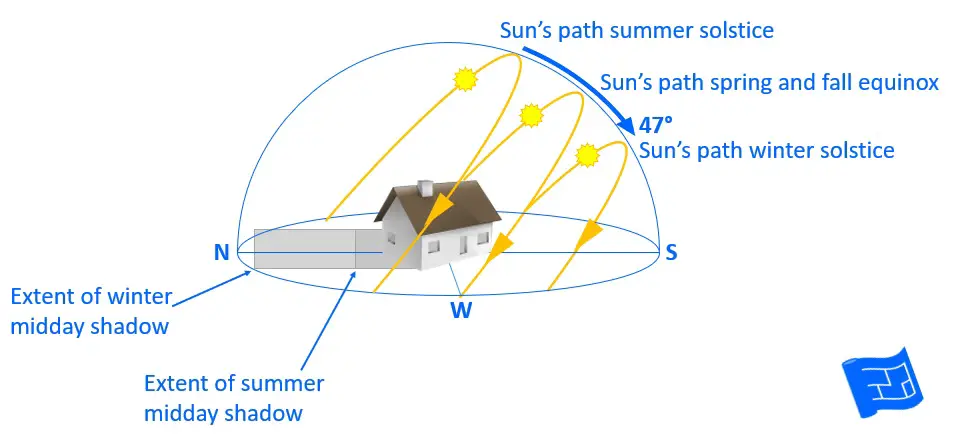
This means the place that the sun rises and sets in relation to your home changes throughout the year. And of course the time that the sun rises and sets changes throughout the year.
So, that explains why we experience the sun as we do.
How will the sun move around my site?
There are several tools that I recommend to get into more detail about how the sun moves around your site.
- SunEarthTools (free) - This is a great site for getting a deep understanding of how the sun moves around your home throughout the year. Go ahead and check it out. There's detailed instructions below to help you as well.
- ShadeMap (free) - This is a great site to see the shadows cast at different times of the year by surrounding buildings or from any buildings already on your site. This one's pretty intuitive so just go ahead and get stuck in.
- Sun Seeker - This is an app for your phone which is very handy when you're physically on site. At time of writing it's $10.00. SunSeeker on Android. SunSeeker on Apple.
Tutorial for ShadeMap
In order to properly consider how light will come into your home, an architect would fully investigate the sun path of the site. Let's have a look at how to do that.
- Go to the sun position tool on SunEarthTools.com
- Enter the address of your site into the search box.
- Check that the timezone is correct - I've found sometimes I need to adjust it.
- Press 'execute'.
- If, for some reason, your address isn't found, find out what the latitude and longitude of your site is (I explain how a bit further down), and enter those coordinates into the search box.
- An image of the sun path around your site will appear.
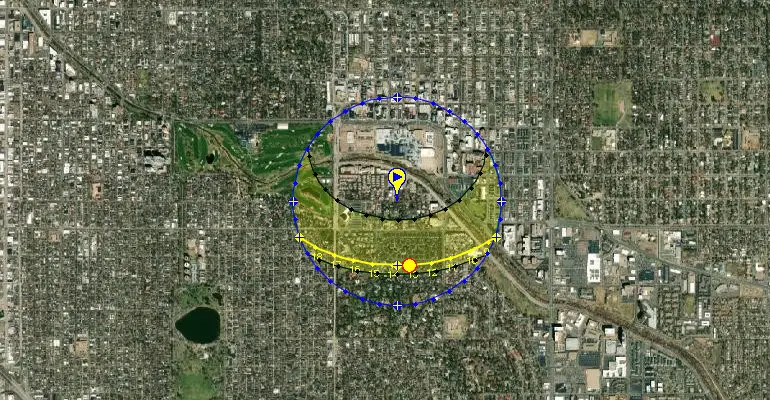
- Scroll down the page and you'll see the more detailed sun path. This is the one we're interested in. Take a screen shot of both representations for your site pack, or there's an option to down load a pdf.
Here's the sun path diagrams for the case study location in Denver.
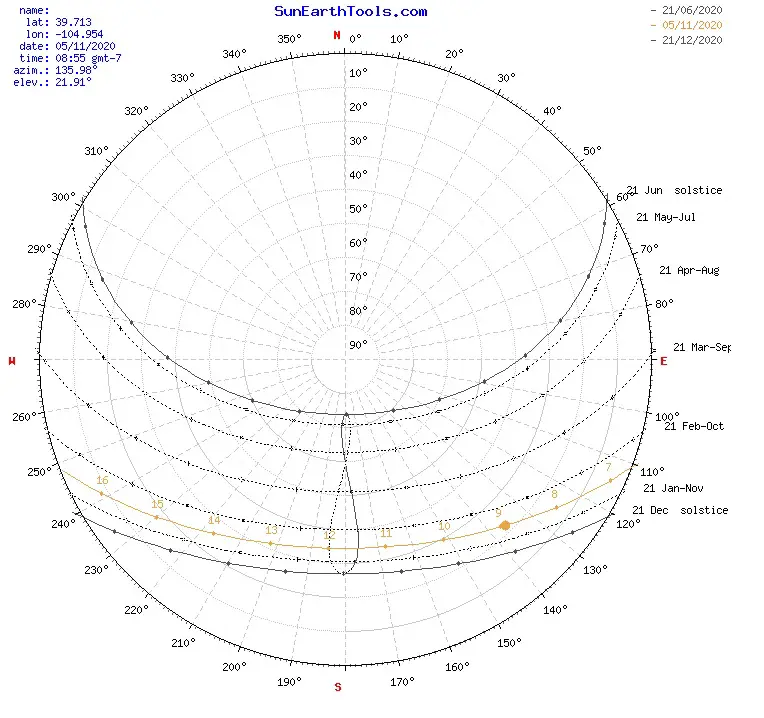
The numbers around the outside of the circle are the azimuth of the sun (amount of degrees east of north) and the numbers going from the edge to the center of the circle is the elevation of the sun (the angle above the horizontal).
On the right hand side you can see the sun paths for different dates labelled. They allow you to see where the sun rises and sets at different times of the year.
The right hand side of the circle is before solar noon. The left hand side of the circle is after solar noon. Note that solar noon does not occur at 12 noon exactly. This is because solar noon changes as latitude changes, yet our time zones change distinctly by an hour.
The figure 8(ish) line is the analemma which is the position of the sun in the sky as seen at solar noon throughout the year.
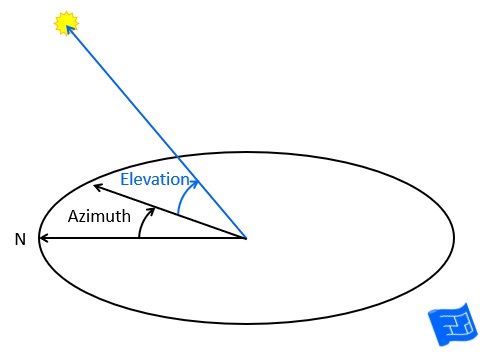
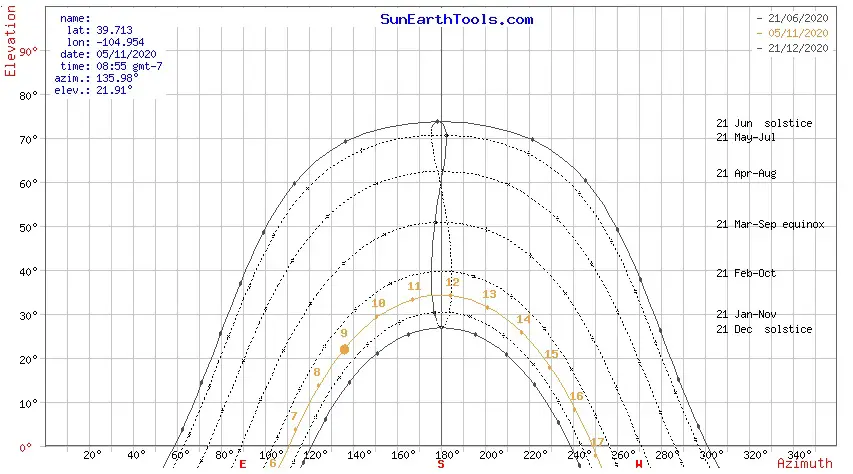
Here the azimuth is along the bottom axis and the elevation is on the side axis.
Both of these representations show the same information, just in different ways.

How to find your latitude and longitude
First, a very quick explanation...
- Latitude - how far north or south you are from the equator - north is positive and south is negative, or you can just say degrees north or degrees south.
- Longitude - how far east or west you are from the prime meridian in Greenwich, London, UK. East is positive and West is negative, your can just say degrees east or degrees west.
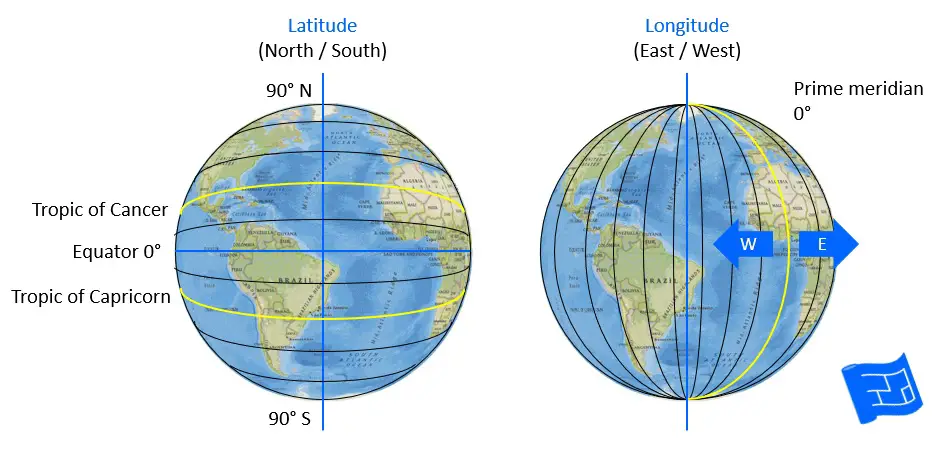
To find your longitude and latitude...
- Open Google maps.
- Search for your address, or find your site and drop a pin in.
- Right click on the map and choose the 'what's here' option. This will display the latitude and longitude in a little box.

The elevation of the sun at the solstices and equinox
As well as your sun path, it's useful to know the maximum elevation of the sun at the June and September solstices and for the equinox.
This information is useful when you need to calculate roof overhangs, or the angle of louvres to shade from the sun.
You can find this information out from Time & Date.
Enter your city and then find the dates of the two solstices (21 June, 21 December) and one for the equinox (21 March or 21 September - it's the same for both dates).
Note down the altitude (means the same as elevation) for your site. For the Denver site...
- 21 June solstice 74 degrees
- Equinox 51 degrees
- 21 December solstice 27 degrees
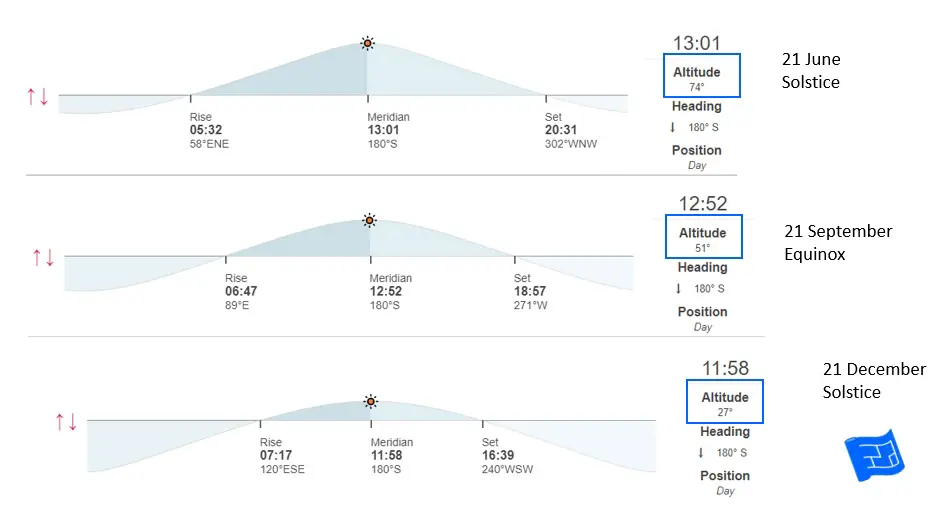
Orientation towards the wind
Don't forget to factor in the direction of the wind when you're considering the site orientation of your home. Are there any breezes that could help cool your home, or any particularly cold winds that you want to protect your home from? Find out more about the climate (including wind) at your site.
The wind will be much more of a factor for your home design if you are in a rural location. In urban areas, the speed of the wind is slower and more turbulent. Urban wind also picks up heat from urban buildings so it of slightly less utility to cool your home. On the flip side, you will be protected from cold winds to some extent by the surrounding buildings.
Wind shadows
Wind shadows are a concept where buildings can be positioned (or the current position taken advantage of)
to protect other parts of your home, usually outdoor space, from prevailing winds.
In the example below the pool house and kitchen create a wind shadow across some of the pool and the majority of outdoor space, while the sleeping quarters are open to the breeze.
The pool house could just as easily be a neighboring home that you can take advantage of to make create a wind shadow in your garden.
Windbreaks
Another concept is windbreaks.
The image below shows how a home in a rural location might be orientated taking the climate into account.
A key factor was to protect from the prevailing winter wind from the north east, while taking advantage of the summer breeze from the south west.
Notice the trees to the north west, which need to be located at a minimum of 100ft or at 5 times the height of the trees from the house in order to give the best protection from the wind.
The home is orientated towards the south to take advantage of the sunshine and the L-shape of the house will capture the summer breeze from the south west, helping to cool the home in the summer.
The deciduous trees surrounding the house will provide shade from the sun in the summer, and allow more sun into the house to heat the home during the winter, when the leaves have fallen.

